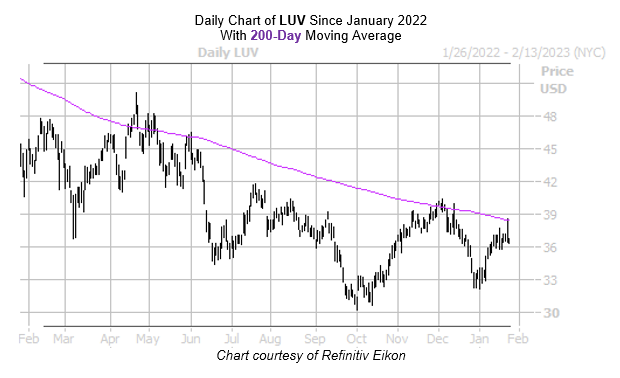Southwest Airlines Stock Flashing Bear Signal Before Earnings
Ahead of its fourth-quarter earnings report, shares of Southwest Airlines Co (NYSE:LUV) are fractionally higher, last seen up 0.3% to trade at $36.77. However, LUV is trading near a historically bearish trendline that could add pressure in the next month.
Specifically, the equity is within one standard deviation of its 200-day moving average. For the purpose of this study, Schaeffer's Senior Quantitative Analyst Rocky White defines that as the equity trading below the moving average for 80% of the time over the past two months, and closing south of the trendline in eight of the last 10 sessions.
According to White's data, five similar signals have occurred during the past three years. Southwest Airlines stock was lower one month later after every one of these signals, averaging a one-month loss of 10.1%. A similar move from the security's current perch of $36.65 would put LUV just above $116.

Southwest Airlines is slated to step into the earnings confession before the open tomorrow, Jan. 26, and analysts are anticipating fourth-quarter losses of 9 cents per share. The stock has a history of negative post-earnings responses, finishing five of eight next-day sessions lower, including a 6.4% dip in July. LUV averaged a move of 2.6% over the last two years, but this time around the options pits are pricing in a bigger swing of 5.7%, regardless of direction.
Speaking of the options pits, traders have favored bearish bets lately. This is per Southwest Airlines stock's 50-day put/call volume ratio of 1.65 that stands higher than all other annual readings, per data at the International Securities Exchange (ISE), Cboe Options Exchange (CBOE), and NASDAQ OMX PHLX (PHLX). What's more, LUV boasts a Schaeffer's put/call open interest ratio (SOIR) of 1.13 that stands above 100% of readings from the past year.
Those looking to join these traders could do so for a bargain right now. This is per the security's Schaeffer's Volatility Index (SVI) of 35% that stands in the relatively low 14% annual percentile. This implies options traders are pricing in low volatility expectations at the moment.
